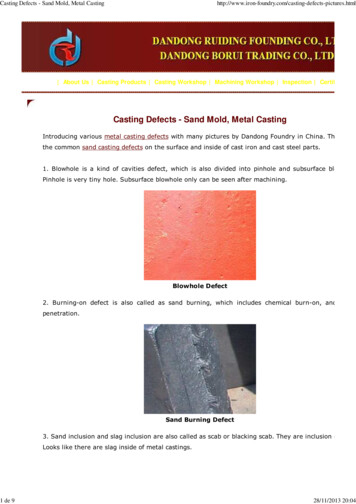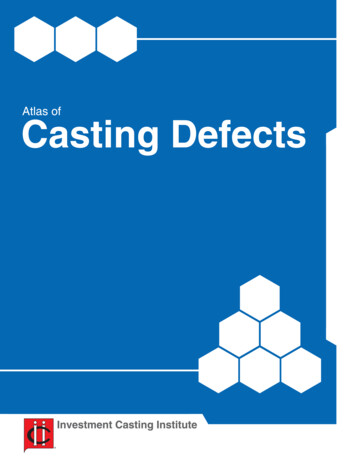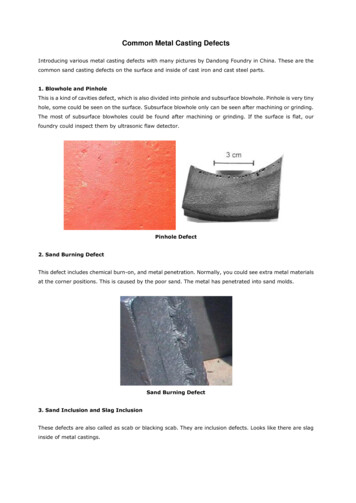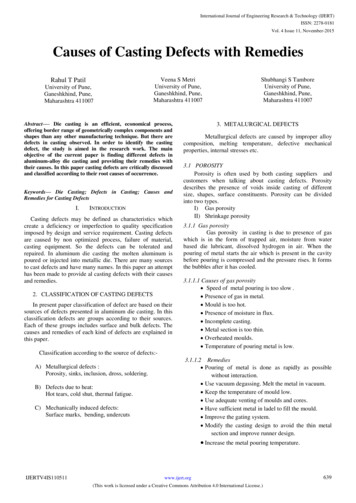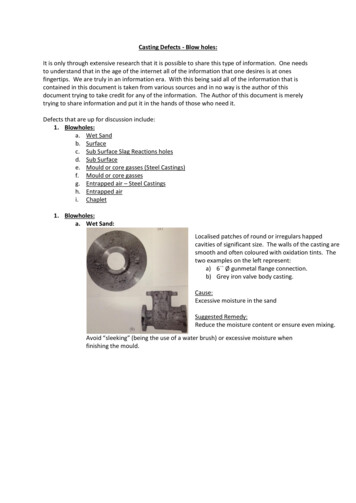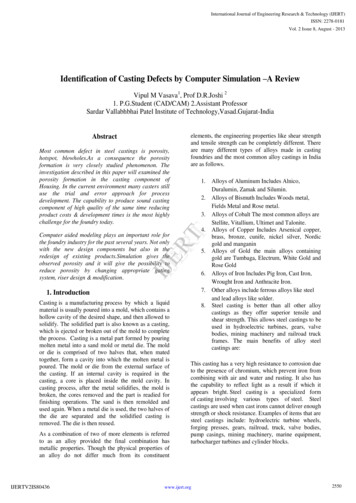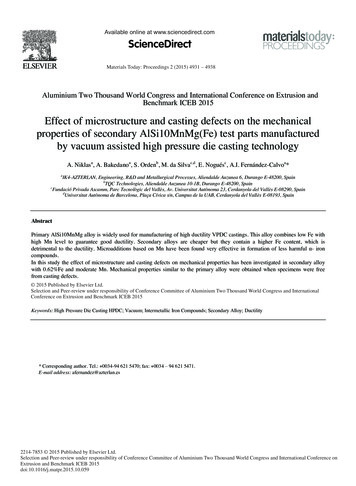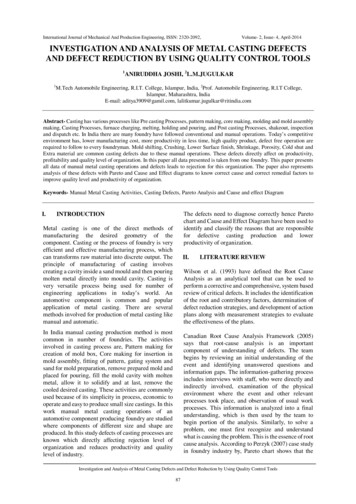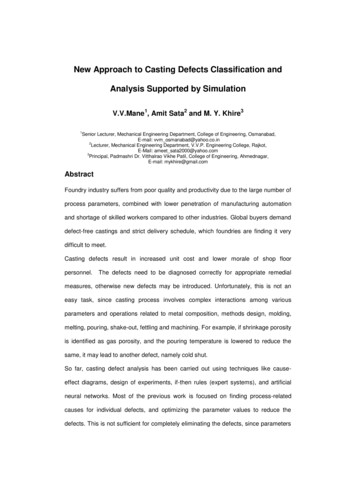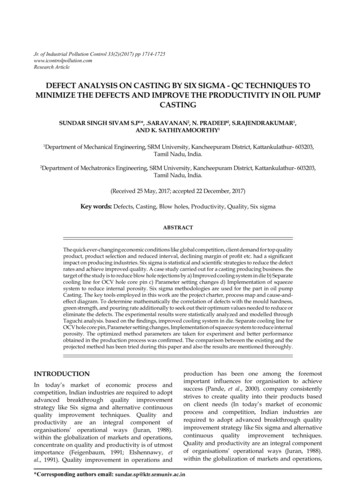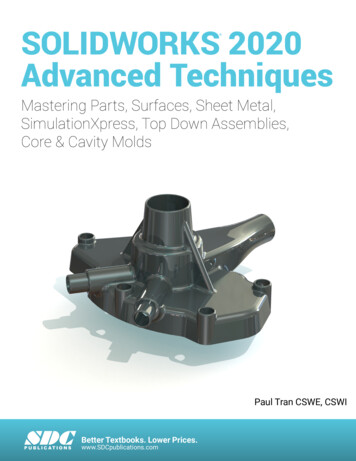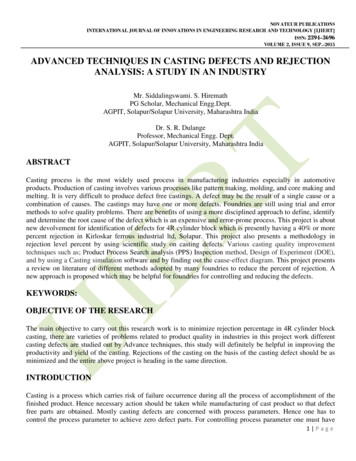
Transcription
NOVATEUR PUBLICATIONSINTERNATIONAL JOURNAL OF INNOVATIONS IN ENGINEERING RESEARCH AND TECHNOLOGY [IJIERT]ISSN: 2394-3696VOLUME 2, ISSUE 9, SEP.-2015ADVANCED TECHNIQUES IN CASTING DEFECTS AND REJECTIONANALYSIS: A STUDY IN AN INDUSTRYMr. Siddalingswami. S. HiremathPG Scholar, Mechanical Engg.Dept.AGPIT, Solapur/Solapur University, Maharashtra IndiaDr. S. R. DulangeProfessor, Mechanical Engg. Dept.AGPIT, Solapur/Solapur University, Maharashtra IndiaABSTRACTCasting process is the most widely used process in manufacturing industries especially in automotiveproducts. Production of casting involves various processes like pattern making, molding, and core making andmelting. It is very difficult to produce defect free castings. A defect may be the result of a single cause or acombination of causes. The castings may have one or more defects. Foundries are still using trial and errormethods to solve quality problems. There are benefits of using a more disciplined approach to define, identifyand determine the root cause of the defect which is an expensive and error-prone process. This project is aboutnew devolvement for identification of defects for 4R cylinder block which is presently having a 40% or morepercent rejection in Kirloskar ferrous industrial ltd, Solapur. This project also presents a methodology inrejection level percent by using scientific study on casting defects. Various casting quality improvementtechniques such as; Product Process Search analysis (PPS) Inspection method, Design of Experiment (DOE),and by using a Casting simulation software and by finding out the cause-effect diagram. This project presentsa review on literature of different methods adopted by many foundries to reduce the percent of rejection. Anew approach is proposed which may be helpful for foundries for controlling and reducing the defects.KEYWORDS:OBJECTIVE OF THE RESEARCHThe main objective to carry out this research work is to minimize rejection percentage in 4R cylinder blockcasting, there are varieties of problems related to product quality in industries in this project work differentcasting defects are studied out by Advance techniques, this study will definitely be helpful in improving theproductivity and yield of the casting. Rejections of the casting on the basis of the casting defect should be asminimized and the entire above project is heading in the same direction.INTRODUCTIONCasting is a process which carries risk of failure occurrence during all the process of accomplishment of thefinished product. Hence necessary action should be taken while manufacturing of cast product so that defectfree parts are obtained. Mostly casting defects are concerned with process parameters. Hence one has tocontrol the process parameter to achieve zero defect parts. For controlling process parameter one must have1 Page
NOVATEUR PUBLICATIONSINTERNATIONAL JOURNAL OF INNOVATIONS IN ENGINEERING RESEARCH AND TECHNOLOGY [IJIERT]ISSN: 2394-3696VOLUME 2, ISSUE 9, SEP.-2015knowledge about effect of process parameter on casting and their influence on defect. To obtain this allknowledge about casting defect, their causes, and defect remedies one has to be analyze casting defects.Casting defect analysis is the process of finding root causes of occurrence of defects in the rejection of castingand taking necessary step to reduce the defects and to improve the casting yield. In this review paper anattempt has been made to provide all casting related defect with their causes and remedies. During the processof casting, there is always a chance where defect will occur. Minor defect can be adjusted easily but highrejected rates could lead to significant change at high cost. Therefore it is essential for die caster to haveknowledge on the type of defect and be able to identify the exact root cause, and their remedies.CASTING DEFECTS CAN BE CLASSIFIED AS FOLLOWS1. Filling related defect2. Shape related defect3. Thermal defect4. Defect by appearanceThese defects are explained as follows. Filling related defectsBlowhole: - Blowhole is a kind of cavities defect, which is also divided into pinhole and subsurface blowhole.Pinhole is very tiny hole. Subsurface blowhole only can be seen after machining. Gases entrapped bysolidifying metal on the surface of the casting, which results in a rounded or oval blowhole as a cavity.Frequently associated with slags or oxides The defects are nearly always located in the cope part of the mouldin poorly vented pockets and undercuts.Sand burning: - Burning-on defect is also called as sand burning, which includes chemical burn-on, andmetal penetration. Thin sand crusts firmly adhering to the casting. The defect occurs to a greater extent in thecase of thick-walled castings and at high temperatures. The high temperature to which the sand is subjectedcauses sintering of the bentonite and silicate components. In addition, the always present iron oxides combinewith the low-melting-point silicates to form iron silicates, thereby further reducing the sinter point of the sand.Sintering and melting of the impurities in the moulding sand enable the molten iron to penetrate even faster,these layers then frequently and firmly adhering to the casting surfaceSand inclusion: - Sand inclusion and slag inclusion are also called as scab or blacking scab. They areinclusion defects. Looks like there is slag inside of metal castings. Irregularly formed sand inclusions, close tothe casting surface, combined with metallic protuberances at other points. Sand inclusion is one of the mostfrequent causes of casting rejection. It is often difficult to diagnose, as these defects generally occur at widelyvarying positions and are therefore very difficult to attribute to a local cause. Areas of sand are often tornaway by the metal stream and then float to the surface of the casting because they cannot be wetted by themolten metal. Sand inclusions frequently appear in association with CO blowholes and slag particles. Sandinclusions can also be trapped under the casting surface in combination with metal oxides and slag’s, and onlybecome visible during machining. If a loose section of sand is washed away from one part of the mould,metallic protuberances will occur here and have to be removed.2 Page
NOVATEUR PUBLICATIONSINTERNATIONAL JOURNAL OF INNOVATIONS IN ENGINEERING RESEARCH AND TECHNOLOGY [IJIERT]ISSN: 2394-3696VOLUME 2, ISSUE 9, SEP.-2015Cold lap or cold shut: - Cold lap or also called as cold shut. It is a crack with round edges. Cold lap isbecause of low melting temperature or poor gating system. When the metal is unable to fill the mould cavitycompletely and thus leaving unfilled portion called misrun. A cold shunt is called when two metal streams donot fuse together properly.Misrun: - Misrun defect is a kind of incomplete casting defect, which causes the casting uncompleted. Theedge of defect is round and smooth. When the metal is unable to fill the mould cavity completely and thusleaving unfilled portion called misrun. A cold shunt is called when two metal streams do not fuse togetherproperly.Gas porosity: - The gas can be from trapped air, hydrogen dissolved in aluminum alloys, moisture from waterbased die lubricants or steam from cracked cooling lines. Air is present in the cavity before the shot. It caneasily be trapped as the metal starts to fill the cavity. The air is then compressed as more and more metalstreams into the cavity and the pressure rises. When the cavity is full it becomes dispersed as small spheres ofhigh pressure air. The swirling flow can cause them to become elongated. Shape defectsMismatch defect: - Mismatch in mold defect is because of the shifting molding flashes. It will cause thedislocation at the parting line.Distortion or warp: - Warped Casting—Distortion due to warp age is known as warp defect.Flash defect: - Flash can be described as any unwanted, excess metal which comes out of the die attached tothe cavity or runner. Typically it forms a thin sheet of metal at the parting faces. There are a number ofdifferent causes of flash and the amount and severity can vary from a minor inconvenience to a major qualityissue. At the very least, flash is waste material, which mainly turns into dross when re-melted, and therefore isa hidden cost to the business. Thermal defectsCracks or tears: - Cracks can appear in die castings from a number of causes. Some cracks are very obviousand can easily be seen with the naked eye. Other cracks are very difficult to see without magnification.Shrinkage: - Shrinkage defects occur when feed metal is not available to compensate for shrinkage as themetal solidifies. Shrinkage defects can be split into two different types: open shrinkage defects and closedshrinkage defects. Open shrinkage defects are open to the atmosphere, therefore as the shrinkage cavity formsair compensates. There are two types of open air defects: pipes and caved surfaces. Pipes form at the surfaceof the casting and burrow into the casting, while caved surfaces are shallow cavities that form across thesurface of the casting. Closed shrinkage defects, also known as shrinkage porosity, are defects that formwithin the casting. Isolated pools of liquid form inside solidified metal, which are called hot spots. Theshrinkage defect usually forms at the top of the hot spots. They require a nucleation point, so impurities anddissolved gas can induce closed shrinkage defects. The defects are broken up into macro porosity and microporosity (or micro shrinkage), where macro porosity can be seen by the naked eye and micro porosity cannot3 Page
NOVATEUR PUBLICATIONSINTERNATIONAL JOURNAL OF INNOVATIONS IN ENGINEERING RESEARCH AND TECHNOLOGY [IJIERT]ISSN: 2394-3696VOLUME 2, ISSUE 9, SEP.-2015Sink mark and void: - Sink marks and voids both result from localized shrinkage of the material at thicksections without sufficient compensation. Sink marks appear as depressions on the surface of a molded part.These depressions are typically very small; however they are often quite visible, because they reflect light indifferent directions to the part. The visibility of sink marks is a function of the color of the part as well as itssurface texture so depth is only one criterion. Although sink marks do not affect part strength or function, theyare perceived to be severe quality defects. Voids are holes enclosed inside a part. These can be a single hole ora group of smaller holes. Voids are caused when the outer skin of the part is stiff enough to resist theshrinkage forces thus preventing a surface depression. Instead, the material core will shrink, creating voidsinside the part. Voids may have severe impact on the structural performance of the part. moldings sink markand void. Defects by AppearanceMetallic projection Joint flash or fins. : - Flat projection of irregular thickness, often with lacy edges,perpendicular to one of the faces of the casting. It occurs along the joint or parting line of the mold, at a coreprint, or wherever two elements of the mold intersect.Cavities: - Blowholes, pinholes, Smooth-walled cavities, essentially spherical, often not contacting theexternal casting surface (Blowholes). The defect can appear in all regions of the casting.Discontinuities: - Hot cracking. A crack often scarcely visible because the casting in general has notseparated into fragments. The fracture surfaces may be discolored because of oxidation. The design of thecasting is such that the crack would not be expected to result from constraints during cooling.Incomplete casting: - Poured short. The upper portion of the casting is missing. The edges adjacent to themissing section are slightly rounded; all other contours conform to the pattern. The spree, risers and lateralvents are filled only to the same height above the parting line, as is the casting.Incorrect dimension or shape: - Distorted casting. Inadequate thickness, extending over large areas of thecope or drag surfaces at the time the mold is rammed.Defective surface Flow marks. : - On the surfaces of otherwise sound castings, the defect appears as lineswhich trace the flow of the streams of liquid metalRat Tail and Buckles: - Rat tails and buckles are caused by the expansion of a thin outer layer of mouldingsand on the surface of the mould cavity due to metal heat.LITERATURE SURVEY1) C. M. Choudhari, B. E. Narkhede, S. K. Mahajan have studied The casting defects can be minimizedby an intelligent methoding and simulation using casting software. The software simulates the way castingengineers decides the casting process, parting line, cores, mould box, feeders, gating system and mouldlayout, and analyzes each decision to suggest how the design could be modified to improve quality as well asreduce tooling and manufacturing costs. Hence casting solidification simulation enables predicting andpreventing potential problems before freezing the product design, determining ‘good first’ methodology4 Page
NOVATEUR PUBLICATIONSINTERNATIONAL JOURNAL OF INNOVATIONS IN ENGINEERING RESEARCH AND TECHNOLOGY [IJIERT]ISSN: 2394-3696VOLUME 2, ISSUE 9, SEP.-2015solutions to achieve high yield at the desired quality level, and evolving optimal process plans compatiblewith both product requirements and foundry capability. The methodology involves four major decisions: (1)orientation and parting line, (2) core print design, (3) feeder design, and (4) gating design. The objective ofthis research work is to carryout numerical simulation of casting solidification with experimental trials tominimize above mentioned defects. Casting simulation and analysis has been studied by many researchers andtheir achievement and limitations are taken into account while solving the case study. The solidificationphenomena in sand mould for thermal stress using finite element analysis has been carried out and author hasdiscussed about the effect of solidification on stress formation in casting where the experimental data wasavailable [4]. The defect
knowledge about casting defect, their causes, and defect remedies one has to be analyze casting defects. Casting defect analysis is the process of finding root causes of occurrence of defects in the rejection of casting and taking necessary step to reduce the defects and to improve the casting yield. In this review paper an attempt has been made to provide all casting related defect with their .
